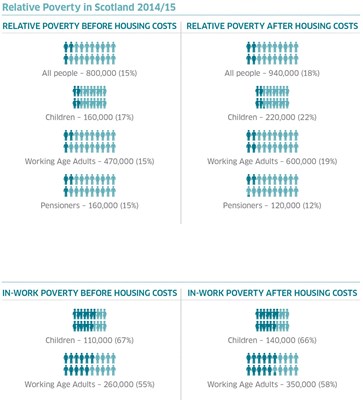Poverty in Scotland 2014/15
A National Statistics Publication for Scotland.
Statistics on poverty in Scotland in 2014/15 show a complex picture.
Relative poverty before housing costs (BHC) increased in 2014/15. While incomes for poorer households increased in 2014/15, middle income households saw a greater increase.
- In 2014/15, 800,000 people (15%) in Scotland were living in relative poverty, BHC. This was an increase from 730,000 (14%) the previous year.
However, there were also real terms decreases in housing costs for those on a low income, which led to after housing costs (AHC) poverty remaining unchanged.
- In 2014/15, 940,000 people (18%) were living in relative poverty, AHC. This was the same as the previous year.
Absolute poverty considers whether living standards for those on low incomes are keeping pace with inflation. In 2014/15, incomes were higher, inflation was low, and housing costs were lower than the previous year. This meant that absolute poverty remained unchanged BHC, while there were fewer households in absolute poverty AHC.
Child material deprivation decreased in 2014/15. Moves into employment, especially for those in lower income households, led to increases in household income. This, combined with low inflation, meant fewer children lacking the basic necessities.
There was also a decrease in the number of children living in workless households in 2014/15. However, the move was largely into part-time employment, especially for lone parents. For working families who also receive benefit income, especially families with children, increases in earnings were balanced against reductions in benefit income, combined with a one per cent cap on benefit up-rating. People not in employment and reliant on benefit income saw the smallest increase in income in 2014/15.
The proportion of people in poverty in working households increased in the latest year. Two thirds of children in poverty lived in working households in 2014/15. The move into employment was largely into part-time work, especially for women, meaning that while people were in employment, they remained in poverty.
In 2014/15, income inequality increased. The top ten per cent of households saw the largest increases in income while the bottom ten per cent saw no real change. This has stretched the income distribution, resulting in low income households falling behind those in the middle and even further behind those at the top.
Notes to editors
The full statistical publication is available at:
http://gov.scot/Publications/2016/06/3468
An easy-read summary of statistics on poverty in Scotland has also been produced. This has been developed jointly with the Poverty Truth Commission (PTC) and includes the main statistical headlines alongside contributions from people with experience of living in poverty.
http://gov.scot/Publications/2016/06/5456/1
This publication contains information on poverty and income inequality statistics for Scotland. Figures presented here are from the Department for Work and Pensions’ Family Resources Survey, Households Below Average Income dataset. Comparable UK income and poverty figures are published on the same day by DWP. See the DWP website for further details.
https://www.gov.uk/government/collections/households-below-average-income-hbai--2
Further information on income and poverty statistics within Scotland can be accessed at: http://www.scotland.gov.uk/Topics/Statistics/Browse/Social-Welfare
The 2014/15 publication includes changes to the publication compared with previous publications:
* The inflation measure used for comparing within and between years has changed from RPI to CPI.
* The publication incorporates the increases in the qualifying age for women to receive the state pension.
See publication for explanation of these changes.
The way in which housing costs are treated when measuring income has some important implications for poverty analysis and conclusions about the anti-poverty effects of policy reforms. This is because the number of people counted as poor (e.g. with income falling below a threshold) depends crucially on the income concept adopted. This publication presents relative and absolute poverty before and after housing costs, material deprivation before and after housing costs, and in-work poverty before and after housing costs.
Equivalisation is the process by which household income is adjusted to take into account variations in the size and composition of the households in which individuals live. This reflects the notion that, in order to enjoy a comparable standard of living, larger households will need a higher income than smaller households. The process of adjusting income in this way is known as equivalisation and is needed in order to make sensible income comparisons between households.
Official statistics are produced by professionally independent statistical staff – more information on the standards of official statistics in Scotland can be assessed at: http://www.scotland.gov.uk/Topics/Statistics/About.
There is a problem
Thanks for your feedback
